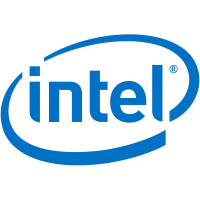AMD EPYC 9124 vs Intel Xeon E3-1260L v5
Comparative analysis of AMD EPYC 9124 and Intel Xeon E3-1260L v5 processors for all known characteristics in the following categories: Essentials, Performance, Memory, Compatibility, Peripherals, Graphics, Graphics interfaces, Graphics image quality, Security & Reliability, Advanced Technologies, Virtualization. Benchmark processor performance analysis: PassMark - Single thread mark, PassMark - CPU mark, Geekbench 4 - Single Core, Geekbench 4 - Multi-Core.
Differences
Reasons to consider the AMD EPYC 9124
- 12 more cores, run more applications at once: 16 vs 4
- 24 more threads: 32 vs 8
- A newer manufacturing process allows for a more powerful, yet cooler running processor: 5 nm vs 14 nm
- 7.2x better performance in PassMark - CPU mark: 59325 vs 8237
| Specifications (specs) | |
| Number of cores | 16 vs 4 |
| Number of threads | 32 vs 8 |
| Manufacturing process technology | 5 nm vs 14 nm |
| Max number of CPUs in a configuration | 2 vs 1 |
| Benchmarks | |
| PassMark - CPU mark | 59325 vs 8237 |
Reasons to consider the Intel Xeon E3-1260L v5
- Around 5% higher clock speed: 3.90 GHz vs 3.7 GHz
- 4.4x lower typical power consumption: 45 Watt vs 200 Watt
- Around 5% better performance in PassMark - Single thread mark: 2316 vs 2204
| Specifications (specs) | |
| Maximum frequency | 3.90 GHz vs 3.7 GHz |
| Thermal Design Power (TDP) | 45 Watt vs 200 Watt |
| Benchmarks | |
| PassMark - Single thread mark | 2316 vs 2204 |
Compare benchmarks
CPU 1: AMD EPYC 9124
CPU 2: Intel Xeon E3-1260L v5
| PassMark - Single thread mark |
|
|
||||
| PassMark - CPU mark |
|
|
| Name | AMD EPYC 9124 | Intel Xeon E3-1260L v5 |
|---|---|---|
| PassMark - Single thread mark | 2204 | 2316 |
| PassMark - CPU mark | 59325 | 8237 |
| Geekbench 4 - Single Core | 4423 | |
| Geekbench 4 - Multi-Core | 14711 |
Compare specifications (specs)
| AMD EPYC 9124 | Intel Xeon E3-1260L v5 | |
|---|---|---|
Essentials |
||
| Launch date | 10 Nov 2022 | Q4'15 |
| Launch price (MSRP) | $1083 | |
| Place in performance rating | 394 | 316 |
| Architecture codename | Skylake | |
| Processor Number | E3-1260LV5 | |
| Series | Intel® Xeon® Processor E3 v5 Family | |
| Status | Launched | |
| Vertical segment | Server | |
Performance |
||
| Base frequency | 3 GHz | 2.90 GHz |
| Die size | 4x 72 mm² | |
| L1 cache | 64K (per core) | |
| L2 cache | 1MB (per core) | |
| L3 cache | 64MB (shared) | |
| Manufacturing process technology | 5 nm | 14 nm |
| Maximum frequency | 3.7 GHz | 3.90 GHz |
| Number of cores | 16 | 4 |
| Number of threads | 32 | 8 |
| Transistor count | 26,280 million | |
| Unlocked | ||
| 64 bit support | ||
| Bus Speed | 8 GT/s DMI3 | |
| VID voltage range | 0.55V-1.52V | |
Memory |
||
| ECC memory support | ||
| Supported memory types | DDR5-4800 MHz, Twelve-channel | DDR4-1866/2133, DDR3L-1333/1600 @ 1.35V |
| Max memory channels | 2 | |
| Maximum memory bandwidth | 34.1 GB/s | |
| Maximum memory size | 64 GB | |
Compatibility |
||
| Configurable TDP | 200-240 Watt | |
| Max number of CPUs in a configuration | 2 | 1 |
| Sockets supported | SP5 | FCLGA1151 |
| Thermal Design Power (TDP) | 200 Watt | 45 Watt |
| Low Halogen Options Available | ||
| Package Size | 37.5mm x 37.5mm | |
Peripherals |
||
| PCIe configurations | Gen 5, 128 Lanes, (CPU only) | 1x16, 2x8, 1x8+2x4 |
| Max number of PCIe lanes | 16 | |
| PCI Express revision | 3.0 | |
| Scalability | 1S Only | |
Graphics |
||
| Intel® Clear Video HD technology | ||
| Intel® Clear Video technology | ||
| Intel® InTru™ 3D technology | ||
| Intel® Quick Sync Video | ||
Graphics interfaces |
||
| Number of displays supported | 0 | |
Graphics image quality |
||
| 4K resolution support | ||
Security & Reliability |
||
| Execute Disable Bit (EDB) | ||
| Intel® Memory Protection Extensions (Intel® MPX) | ||
| Intel® OS Guard | ||
| Intel® Secure Key technology | ||
| Intel® Software Guard Extensions (Intel® SGX) | ||
| Intel® Trusted Execution technology (TXT) | ||
| Secure Boot | ||
Advanced Technologies |
||
| Enhanced Intel SpeedStep® technology | ||
| Idle States | ||
| Instruction set extensions | Intel® SSE4.1, Intel® SSE4.2, Intel® AVX2 | |
| Intel 64 | ||
| Intel® AES New Instructions | ||
| Intel® Hyper-Threading technology | ||
| Intel® TSX-NI | ||
| Intel® Turbo Boost technology | ||
| Intel® vPro™ Platform Eligibility | ||
| Thermal Monitoring | ||
Virtualization |
||
| Intel® Virtualization Technology (VT-x) | ||
| Intel® Virtualization Technology for Directed I/O (VT-d) | ||
| Intel® VT-x with Extended Page Tables (EPT) | ||









